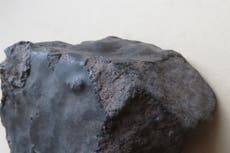Giant space ‘umbrella’ tethered to asteroid could protect Earth from climate crisis, study says
Research estimates type of ’umbrella’ needed to achieve solar radiation reduction by about 1.7 per cent
Scientists have theorised a new approach involving a giant space “umbrella” to use as a solar shield to protect the Earth from excess sunlight and thus help reduce its impact on global heating.
István Szapudi, an astronomer at the University of Hawai’i Institute for Astronomy, said a solar shield tethered to a captured asteroid as a counterweight can be developed into a workable design to mitigate the climate crisis within decades.
With the Earth rapidly warming, scientists across the world are developing a number of new ways to reduce the effects of climate change.
One of the approaches previously proposed to reduce global temperature is to shade the Earth from a fraction of the Sun’s light using a solar “umbrella”.
However, the large amount of weight needed to make such a shield massive enough to balance gravitational forces and prevent solar radiation pressure from blowing it away makes even the lightest materials prohibitively expensive.
In the new study, published recently in the journal PNAS, Dr Szapudi proposes using a tethered counterweight instead of just a massive shield to make the total mass more than 100 times less.
The research theorises that a captured asteroid could be used as the counterweight to avoid launching most of the mass from Earth.
“In Hawai’i, many use an umbrella to block the sunlight as they walk about during the day. I was thinking, could we do the same for Earth and thereby mitigate the impending catastrophe of climate change?” Dr Szapudi said.
The new research estimated the type of such an “umbrella” that would be needed to achieve a goal of reducing solar radiation impact on Earth by about 1.7 per cent – the amount that may be needed to prevent catastrophic rise in global temperatures.
The study found that placing a tethered counterbalance toward the Sun could reduce the weight of the overall shield and counterweight to approximately 3.5 million tons – about 100 times lighter than previous estimates for an untethered shield.
However, this number is far beyond current space launch capabilities from Earth as even the largest rockets can only lift about 50 tons to low Earth orbit.
But by using an asteroid as a counterweight, the study noted that only 1 per cent of the weight – about 35,000 tons – would be the shield itself that needs to be launched from Earth.
And with newer, lighter materials, the mass of the shield can be reduced even further.
Dr Szapudi said such a tethered structure would be faster and cheaper to build and deploy than current shield designs.
Join our commenting forum
Join thought-provoking conversations, follow other Independent readers and see their replies
Comments


Bookmark popover
Removed from bookmarks